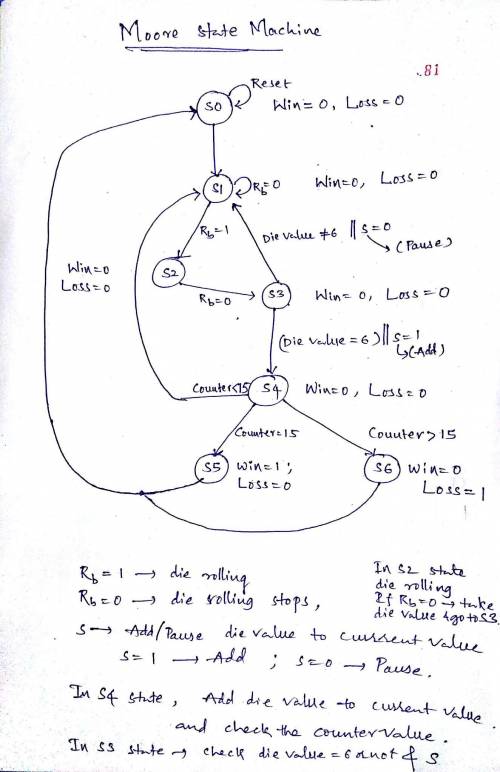
Computers and Technology, 02.06.2020 21:57 genyjoannerubiera
In this lab, you will design a die game called 15. The object of the game is to score exactly 15 points in as few rolls of the die as possible. After each roll, the player can choose to add the current die value to his or her score or not, unless the die value is six, in which case it is automatically added to the player’s score. If the player’s score exceeds 15, the player loses. If the player’s score is equal to 15, the player wins. Play continues until the player reaches or exceeds 15 points.
Description:
To start the game, the player presses the reset switch. The score will be set to zero and both the Win and Lose LEDs will be turned off. The player then rolls the die by toggling the Rb switch to the Roll position. The die counter should operate with a clock frequency of 27 MHz or 50 MHz so that the player cannot control the outcome of a roll. After about a second or more, the player toggles the Rb switch back to the Off position to end the roll. The Turn Counter should be incremented to indicate that the player has taken a roll. If the player rolled a six, it is automatically added to his or her score. Otherwise, the player can press the Add button to add the die value to his or her score or the player can press the Pass button to leave the score unchanged. After each roll, the score will be greater than, less than or equal to 15. If the score is equal to 15, the player wins – the Win LED should be turned on and remain on until the system is reset for a new game. If the score is greater than 15, the player loses – the Lose LED should be turned on and remain on until the system is reset. Once the player has won or lost, the player cannot roll the die again until the system is reset. (The Rb switch will not have any effect in these states.) If the score is less than 15, the player will roll again. After each roll, the player presses either the Add button or the Pass button (unless a six is rolled) before the die can be rolled again. Play continues until the player’s score equals or exceeds 15.
1) Draw a state diagram for the game as a Moore finite state machine.
2) Draw a state diagram for the game as a Mealy finite state machine.

Answers: 3


Another question on Computers and Technology

Computers and Technology, 22.06.2019 11:00
The editing of digital photos us about the same level of difficulty as editing an analog photo
Answers: 2

Computers and Technology, 23.06.2019 02:30
People with high self-esteem: accept their strengths and weaknesses. believe that failed experiences are failures of their whole self. feel good about who they are only when they reach total success. need positive external experiences to counteract negative feelings that constantly plague them.
Answers: 1

Computers and Technology, 23.06.2019 15:30
The song about casey jones a railroad engineer who gives his life on the job would most likely gall under the folk song category of? a-work song b-nonsense song c-religious song d-ballad
Answers: 1

Computers and Technology, 23.06.2019 19:00
Now you’re on your own. include a short summary of this section with plots in your lab report. write a matlab script file to do steps (a) through (d) below. include a listing of the script file with your report. 1 the soundsc(xx,fs) function requires two arguments: the first one (xx) contains the vector of data to be played, the second argument (fs) is the sampling rate for playing the samples. in addition, soundsc(xx,fs) does automatic scaling and then calls sound(xx,fs) to actually play the signal. mcclellan, schafer, and yoder, dsp first, 2e, isbn 0-13-065562-7. prentice hall, upper saddle river, nj 07458. c 2015 pearson education, inc. 4 mcclellan, schafer and yoder, signal processing first. prentice hall, upper saddle river, new jersey, 2003. c 2003 prentice hall. (a) generate a time vector (tt) to cover a range of t that will exhibit approximately two cycles of the 4000 hz sinusoids defined in the next part, part (b). use a definition for tt similar to part 2.2(d). if we use t to denote the period of the sinusoids, define the starting time of the vector tt to be equal to t , and the ending time as ct . then the two cycles will include t d 0. finally, make sure that you have at least 25 samples per period of the sinusoidal wave. in other words, when you use the colon operator to define the time vector, make the increment small enough to generate 25 samples per period. (b) generate two 4000 hz sinusoids with arbitrary amplitude and time-shift. x1.t / d a1 cos.2
Answers: 1
You know the right answer?
In this lab, you will design a die game called 15. The object of the game is to score exactly 15 poi...
Questions

English, 15.09.2019 00:20

Mathematics, 15.09.2019 00:20





English, 15.09.2019 00:20

Mathematics, 15.09.2019 00:20



Mathematics, 15.09.2019 00:20

Mathematics, 15.09.2019 01:10

Mathematics, 15.09.2019 01:10

Physics, 15.09.2019 01:10



Geography, 15.09.2019 01:10

Mathematics, 15.09.2019 01:10

English, 15.09.2019 01:10




